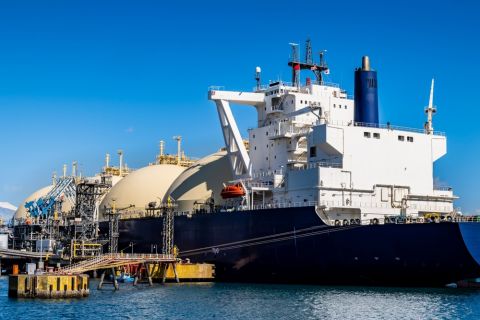
The combined gas reserves in the Gulf Cooperation Council (GCC) is about 1,500 Tcf, but much of the reserve is associated gas and expensive to extract.
The natural gas shortage in the Middle East has again cast its shadow over the ongoing crises in the Arabian Gulf region. While the region as a whole controls more than 40% of global gas reserves, its countries, with the exception of Algeria and Qatar, face a critical lack of supply.
The combined gas reserves in the Gulf Cooperation Council (GCC) total about 1,500 Tcf, but much of it is associated gas and expensive to extract.
Because it is dependent on the Dolphin gas pipeline that links it to Qatar, the UAE has relatively limited immediate options to replace the 2 Bcf/d of gas it imports if Qatar decides to cut off exports to that country. That is considered unlikely to happen.
The UAE also has an LNG import terminal in Dubai with a capacity of 3 mpta and plans to build another terminal in Fujairah with a capacity of 9 mtpa. The country also faces a deficit of 2 Bcf/d during the peak summer season. It is estimated the UAE will need another 5 Bcf/d for extra power capacity by 2019.
The UAE is having difficulty producing enough gas to meet domestic requirements, though it holds about 5% of the world’s proven reserves. Much of it is sulfur-laced sour gas, which is expensive to produce. Sour gas is highly corrosive, and generally more challenging to process because of its high sulfur content, which requires special handling and infrastructure.
The UAE has already identified this issue and tapped the development of its sour gas fields, one of the most challenging types of fields, which are mainly located in Abu Dhabi. The sour gas prospect is estimated by analysts to contain about 5 Tcf of gas and forecast to produce 1 Bcf/d, which would equate to about 18% of the UAE’s current demand.
“Tapping into undeveloped gas reservoirs is part of ADNOC’s focused strategy to drive a more sustainable and economic gas supply,” the director of upstream activities at ADNOC, Abdul Munim al-Kindy told local media.
Production costs of deep and mildly sour gas projects in the Gulf are between $5 per million Btu (MMbut) and $6/MMbtu, but domestic sales prices range from 75 cents to $2, with negligible prices for household, according to local analysts.
Amid the soaring local gas consumption, the UAE decided to develop its sour gas reserves and had already started up production from Shah gas field. For Shah, selecting the right foreign partner wasn’t easy and included many setbacks. Initially, ADNOC selected ConocoPhillips Co. (NYSE: COP) as a partner to develop the project, but in April 2010, ConocoPhillips withdrew from the $10 billion development saying that it intended to shift its operational focus from midstream and downstream activities to upstream work.
But in January 2011, ADONC selected Occidental Petroleum Corp. (NYSE: OXY) as a partner, and set up Al Hosn Gas, a joint venture between ADNOC and Oxy. The project was successfully started up in early 2016. Shah produces a total of 1 billion cubic feet per day (Bcf/d), of which 500 million cubic feet per day (MMcf/d) is delivered to the UAE’s gas grid, as well as producing 33,000 bbl/d of petroleum condensates and 4.4 mtpa of natural gas liquids. Already, Al Hosn has laid out plans to increase output by 50%.
Meanwhile, Bab gas field, another sour gas field, witnessed setbacks as Shell announced in early 2016 that it has pulled out of the $10 billion Bab sour gas project in Abu Dhabi, citing “technical challenges” and the falling price of oil as key factors in its decision. But despite the setbacks, ADNOC is determined to boost its gas output.
In early June, local media reports said that the company is considering greenlighting another huge gas project which could meet nearly 20% of the UAE’s gas demand by the end of the decade. The state oil company’s investment committee is considering proposals for a $20 billion development of the Hail and Ghasha, Delma, Nasr and Shuwaihat “ultra-sour” gasfields, which lie in relatively shallow water southwest of Abu Dhabi.
Recommended Reading
Cove Point LNG Resumes Operations, Boosts US NatGas Deliveries
2024-10-22 - The 0.8 Bcf/d Cove Point LNG facility has resumed operations, according to the project’s operator Berkshire Hathaway Energy.
Hotter Temps Drive Japanese Demand for Spot LNG from US
2024-09-11 - Above-average temperatures are forecast for most regions of Japan through early October, compelling the country to seek prompt LNG, potentially from the U.S., to cover extended summer-related electricity demand.
US Natgas Prices Hold Near 1-week Low Ahead of Hurricane Milton
2024-10-08 - Lower output and higher demand forecasts offset expectations Hurricane Milton could cause millions of homes and businesses to lose power in Florida later this week.
Warmer-than-average US Temps to Pressure Gas Demand Side
2024-09-30 - Higher U.S. temperatures are expected to pressure gas demand for gas-fired electricity, according to a report from Rystad Energy.
US Natural Gas Prices Hold Near 12-week High on Rising Outages
2024-09-24 - U.S. natural gas futures held near a 12-week high as some Gulf Coast oil and gas producers cut output ahead of a possible hurricane.
Comments
Add new comment
This conversation is moderated according to Hart Energy community rules. Please read the rules before joining the discussion. If you’re experiencing any technical problems, please contact our customer care team.




